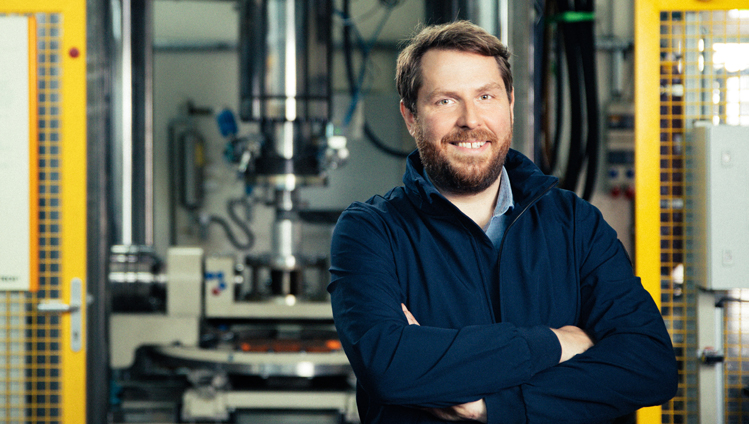In 2021, eMobility seems to be really taking off worldwide. In addition to ever new public declarations of support for new mobility, one vehicle launch follows the next: EQS, ID.4 and F-150 Lightning are just some of the new models that will be roaming our streets at zero emissions in the future. But the brave new mobility also brings challenges, because not every component can be transferred 1:1 from the combustion engine to the electric car. Our experts are only too happy to take on this challenge.
5 Questions for Our Expert Marc Leinemann

Today, we introduce you to one of them: Marc Leinemann, responsible for the development of air suspension systems for commercial vehicles, deals with the effects of eMobility on a daily basis. In this interview, he talks about his day-to-day work, the importance of often inconspicuous components, and his thoughts on the mobility of the future.
Question 1
Marc, what’s your job at Continental?
|

|
Within Continental’s Advanced Development, I’m responsible for the technological path ahead of us when we are working on air spring systems and related technologies for commercial vehicles like trucks and busses. Air springs are adaptive suspension elements for axles, truck cabins and drivers‘ seats – basically all the areas that may lead to unwanted, unsafe or uncomfortable vibrations for either the driver or the load. For example, in a truck, you can usually find air springs at the rear axle – and of course at the trailer axles because that’s where the biggest load differences occur. They make sure that the trip is equally safe for an empty room as for a container filled to the brim with valuable goods. The same goes for busses: Whether it’s one lone passenger late at night or a whole busload of school kids – their ride is just as comfortable. So, in that sense, air springs are very versatile and provide safety as well as comfort. That is why you can find air springs in virtually all trucks, trailers and busses currently running on Europe’s and North America’s streets as well as many urban areas in Asia, Australia, South America and Africa.
|
|
Question 2
How did you get into this job?
|

|
That was quite incremental. After graduating in engineering, I was looking for an internship to gain some practical experience and found one with a company here in Hanover where I also stayed on as a working student. Amongst other products, mainly for axle and body components, they produced air spring components – which were incidentally supplied to Continental. That’s how I was intitially introduced to roller pistons for spring systems. And after a couple of years, I moved on to work directly for Continental.
|
|
Question 3
Do you recognize the impact your work has in real-life?
|

|
Yes, we see it every day. Sometimes it’s more obvious like city busses lowering down one side at the bus stop to make entering and exiting more comfortable. Sometimes it’s less obvious, but air springs are an integral part of today’s transport industry. Nearly all the goods of our daily lives were transported using air suspension – to me, that’s good to know. In our daily jobs, we strive to make air springs even more reliable, robust and adaptive to the changing demands of the worldwide market. And that also includes the systems that are related to their function or the valuable information air springs can provide. So, our work touches a lot of different areas from engineering to materials and leightweight concepts to sensor technology. And Continental offers us the chance to utilize all these synergies, which is fascinating.
|
|
Question 4
You are also involved in developing products for EVs. In your opinion, where does eMobility make most sense for commercial vehicles?
|

|
Clearly eMobility can be most successful in an urban environment. You know, where there is lots of traffic in a condensed area with plenty of stop and go and where the distances aren’t as long as for heavy-load commercial traffic. For example, many small package services have already electrified their fleets. In addition, public transport in cities have also started to transform their bus fleets towards more sustainability. On the other hand, electrifying long-distance traffic or even long-haul carriers is much more difficult because of factors like battery capacity, charging concepts and infrastructure. For longer distances, it’s much easier to imagine a fuel cell approach because the refueling process is quicker and similar to the one we have today with gasoline at gas stations.
|
|
Question 5
What does the future of mobility look like to you?
|

|
When it comes to public transport, we will be waving goodbye to fixed bus lines and timetables. Especially in urban areas, mobility will be more of a service on demand. You can see that already today in ridesharing services offered in bigger cities. I also think that vehicle size in public transport will adapt to demand. You know, busses are usually packed during rush hour and empty in between – but the bus is always the same size. So; in future, I could imagine busses that consist of smaller, modular units that can be connected as necessary. And driverless vehicles will also play a major role in the future. Now, these are not incremental steps but almost revolutionary decisions that need courage and a lot of transparency in politics, the economy and society in general, especially when it comes costs and the investment needed to provide the infrastructure and energy supply for the vehicles. So, we’ll see what the future brings.
|
|